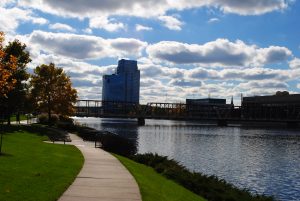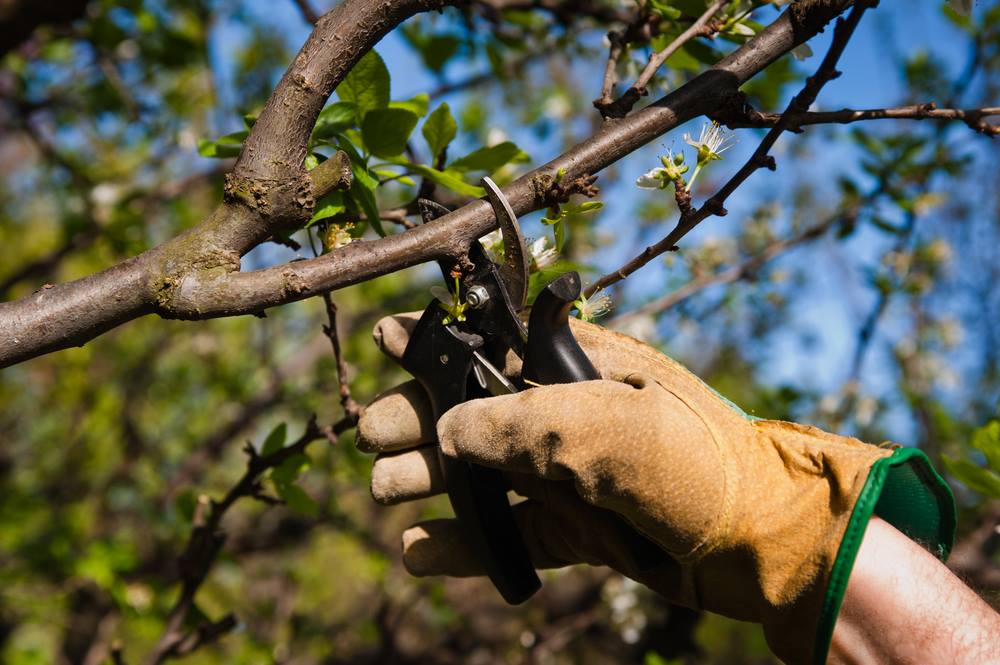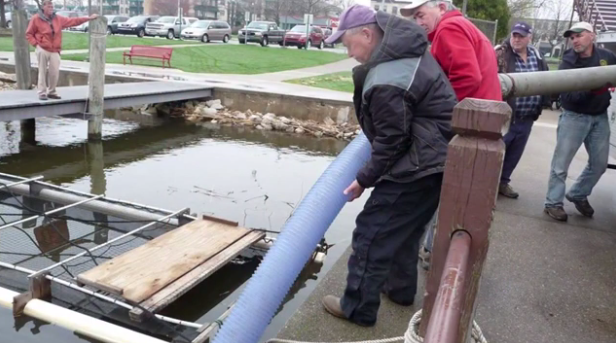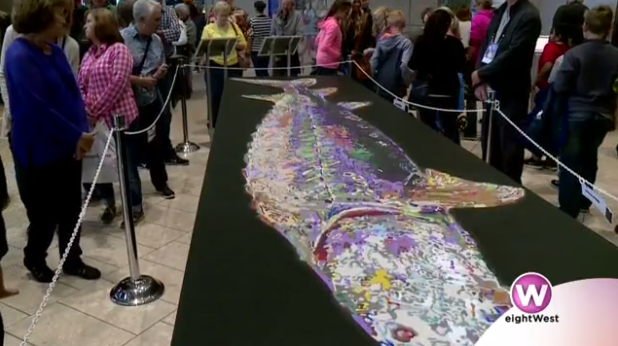
Trees are Angela Schmidt's happy place.
Surrounded by their green goodness, the 45-year-old happily recalls childhood summers spent exploring neighborhood parks or camping with her family.
"I think nature was always important to me since I grew up spending every summer either camping or at (Lincoln Park) at the end of our block," said Schmidt. "After my diagnosis, one of my best calming medicines was going back to nature."
Today, Schmidt is cancer-free and taking her love of trees one step further by becoming certified as a citizen forester through the Grand Rapids Urban Forest Project. The initiative of Friends of Grand Rapids Parks in partnership with the City of Grand Rapids seeks to engage the entire community in planting and growing a larger, healthier urban forest.
"Trees are vital to the well-being of any community. Most people know their importance environmentally, but there are also economic, social and cultural benefits to living in a place where trees are plentiful," said Margaret Studer, director of the Grand Rapids Urban Forest Project.
How many trees are enough?
Merisa Campbell of the Michigan Wildlife Council, a state panel that promotes the importance of conservation and wildlife management, said the Urban Forest Project is an example of the diverse array of efforts to protect the state's natural resources.
"Whether it's performed by citizen volunteers, or occurs in an urban or rural setting, every conservation project makes a difference in ensuring future generations will be able to enjoy our forests, waters and wildlife," Campbell said.
A community's urban forest is made up of every tree found there – in parks, along streets, in golf courses and backyards. An urban forest canopy is defined as the ratio of total land area covered by trees.
In Grand Rapids, there are 75 tree species planted along their streets; the most common are sugar maple, box elder, American elm, white ash and black locust. More than half of these "street trees" are maples.
In 2011, the city of Grand Rapids adopted a tree canopy goal of 40 percent. Currently, the city's tree canopy is 34.6 percent – the same as the previous analysis in 2008.
"Considering the devastation here and in many American cities from the emerald ash borer, which destroyed thousands of trees in Grand Rapids, we've done pretty well. But we will continue working toward our goal of 40 percent," Studer said.
The city's current canopy is 9,775 acres; an additional 1,640 acres of tree cover are needed to meet the city's 40 percent goal.
"Trees have an incredible benefit to any community," said David Marquardt, director of Grand Rapids Parks and Recreation. "The more tree canopy coverage we have, the better we can slow down rainwater and the erosion of our public and private lands and keep it from entering our lakes, rivers and streams."
To encourage residents to help expand the tree canopy, the city launched the Urban Forest Project five years ago. The group provides education and training to volunteers to help them become knowledgeable about tree planting, maintenance and identification.

Trees have intangible perks
Angela Schmidt learned about the Urban Forest Project in 2014 after taking a leave of absence from her work as a psychologist to undergo surgery and radiation treatment, as well as to devote more time to her partner, Tim Stack, and their four sons. That fall, her son Salvador Mercado needed some help on a tree identification project.
"The people at the Urban Forest Project helped Salvador identify trees for a mammoth school project he had and told him about the tree canopy in the city and how they were trying to increase it. Salvador and I found it very interesting," she said.
Schmidt and her family live just blocks from Briggs and Riverside parks in northeast Grand Rapids and spend plenty of time there. As she recovered from cancer, Schmidt said she found healing in nature.
"I know from my work ... that spending time in nature can reduce your stress levels, your cortisol levels, and just give a person that meditative or mindful feeling," said Schmidt, who began her citizen forester training this spring.
"We want our kids to be able to grow up with an appreciation of nature. So the way to do that is to be involved in it and pay it forward," she said.
Citizen Forester program growing
Events like After Work Tree Time – periodic get-togethers organized by the Urban Forest Project – are a great chance for volunteers like Schmidt to care for city trees in local neighborhoods.
"I was a little worried about whether I'd fit in at these things. But they're regular people just like me," Schmidt said. "They're not lumberjacks. They're young and energetic. ... How can this not be good for everybody to be around this fun, positive environment?"

Citizen foresters must attend four indoor classes and two outdoor events to become certified. There are already 50 Grand Rapids folks who are certified and another 150 in training, Studer said.
"In the beginning, it was word-of-mouth. Now it's really diversified and it's become something a lot of people are passionate about," Studer said.
In light of the urbanization and growth in Grand Rapids, the city in 2015 enacted zoning ordinances requiring all developers to maintain a parcel's tree canopy cover.
"We're just saying if you have to remove trees for a building project, you have to replace it with new trees. This is a very progressive ordinance, and a lot of cities are looking at us. It's one more way of ensuring our trees are kept safe," Studer explained.
The United States Forest Service encourages urban forest management by providing expertise and federal funding to partners nationally and within each state. In Michigan, this partnership supports the state Department of Natural Resources Urban & Community Forestry Program, which provides education and financial assistance to government and nonprofit agencies.
"Our program supports building awareness, and providing technical and educational expertise to help improve people's understanding of the role trees play in the 'built environment' – whether it's in heavily urbanized areas such as Detroit or in smaller, rural communities throughout the state ," said Kevin Sayers, Urban & Community Forestry Program coordinator.
Financial assistance is available to partners periodically via cost-share grants to help facilitate a variety of projects such as tree planting, training, education and planning across Michigan.
"Trees are vital parts of our community that deserve higher regard than just for their aesthetic beauty. What would our lives be like without healthy and diverse trees in the environment?" Sayers asked.
Schmidt, who is close to receiving her urban forester certification, agrees.
"If there's not anybody there to care for our trees or to make sure we keep planting, then maybe my grandkids aren't going to have the ability to walk out their front door and make a right or left and get to a park," Schmidt said. "We all need to help."



